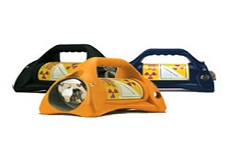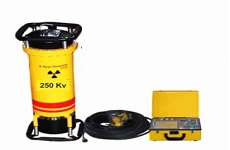Radiography Testing:
Radiographic inspection is based on the exposure by Either an X-ray machine or a radioactive source (Ir-192, Co-60, or in rare cases Cs-137) can be used as a source of photons. Since the amount of radiation emerging from the opposite side of the material can be detected and measured, variations in this amount (or intensity) of radiation are used to determine thickness or composition of material. Penetrating radiations are those restricted to that part of the electromagnetic spectrum of wavelength less than about 10 nanometers. The principle of Industrial Radiography Testing is Differential Absorption. This means that different materials absorb different amount of radiation based on the thickness difference, density and presence of defect. Generally for detection medium is films which consist of an emulsion-gelatin containing radiation sensitive silver halide crystals, such as silver bromide or silver chloride, and a flexible, transparent, blue-tinted base. When x-rays, gamma rays, or light strike the grains of the sensitive silver halide in the emulsion, some of the Br- ions are liberated and captured by the Ag+ ions. This change is of such a small nature that it cannot be detected by ordinary physical methods and is called a "latent (hidden) image." However, the exposed grains are now more sensitive to the reduction process when exposed to a chemical solution (developer), and the reaction results in the formation of black,Metallic silver. It is this silver, suspended in the gelatin on both sides of the base, that creates an image. Radiographic testing provides a permanent record in the form of a radiograph and provides a highly sensitive image of the internal structure of the material.




